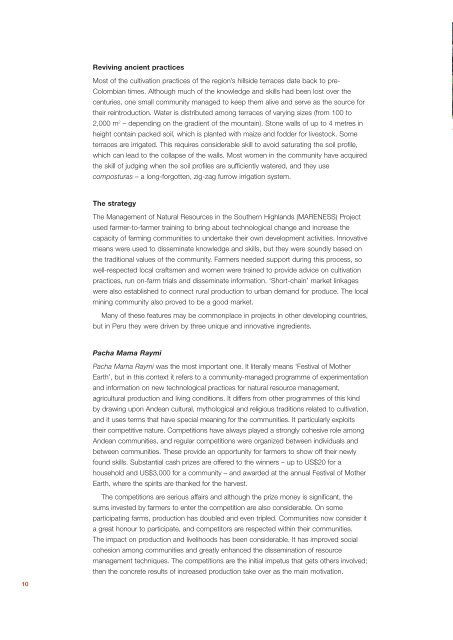Community-based natural resource management - International ...
Community-based natural resource management - International ...
Community-based natural resource management - International ...
You also want an ePaper? Increase the reach of your titles
YUMPU automatically turns print PDFs into web optimized ePapers that Google loves.
10<br />
Reviving ancient practices<br />
Most of the cultivation practices of the region’s hillside terraces date back to pre-<br />
Colombian times. Although much of the knowledge and skills had been lost over the<br />
centuries, one small community managed to keep them alive and serve as the source for<br />
their reintroduction. Water is distributed among terraces of varying sizes (from 100 to<br />
2,000 m2 – depending on the gradient of the mountain). Stone walls of up to 4 metres in<br />
height contain packed soil, which is planted with maize and fodder for livestock. Some<br />
terraces are irrigated. This requires considerable skill to avoid saturating the soil profile,<br />
which can lead to the collapse of the walls. Most women in the community have acquired<br />
the skill of judging when the soil profiles are sufficiently watered, and they use<br />
composturas – a long-forgotten, zig-zag furrow irrigation system.<br />
The strategy<br />
The Management of Natural Resources in the Southern Highlands (MARENESS) Project<br />
used farmer-to-farmer training to bring about technological change and increase the<br />
capacity of farming communities to undertake their own development activities. Innovative<br />
means were used to disseminate knowledge and skills, but they were soundly <strong>based</strong> on<br />
the traditional values of the community. Farmers needed support during this process, so<br />
well-respected local craftsmen and women were trained to provide advice on cultivation<br />
practices, run on-farm trials and disseminate information. ‘Short-chain’ market linkages<br />
were also established to connect rural production to urban demand for produce. The local<br />
mining community also proved to be a good market.<br />
Many of these features may be commonplace in projects in other developing countries,<br />
but in Peru they were driven by three unique and innovative ingredients.<br />
Pacha Mama Raymi<br />
Pacha Mama Raymi was the most important one. It literally means ‘Festival of Mother<br />
Earth’, but in this context it refers to a community-managed programme of experimentation<br />
and information on new technological practices for <strong>natural</strong> <strong>resource</strong> <strong>management</strong>,<br />
agricultural production and living conditions. It differs from other programmes of this kind<br />
by drawing upon Andean cultural, mythological and religious traditions related to cultivation,<br />
and it uses terms that have special meaning for the communities. It particularly exploits<br />
their competitive nature. Competitions have always played a strongly cohesive role among<br />
Andean communities, and regular competitions were organized between individuals and<br />
between communities. These provide an opportunity for farmers to show off their newly<br />
found skills. Substantial cash prizes are offered to the winners – up to US$20 for a<br />
household and US$3,000 for a community – and awarded at the annual Festival of Mother<br />
Earth, where the spirits are thanked for the harvest.<br />
The competitions are serious affairs and although the prize money is significant, the<br />
sums invested by farmers to enter the competition are also considerable. On some<br />
participating farms, production has doubled and even tripled. Communities now consider it<br />
a great honour to participate, and competitors are respected within their communities.<br />
The impact on production and livelihoods has been considerable. It has improved social<br />
cohesion among communities and greatly enhanced the dissemination of <strong>resource</strong><br />
<strong>management</strong> techniques. The competitions are the initial impetus that gets others involved;<br />
then the concrete results of increased production take over as the main motivation.

















